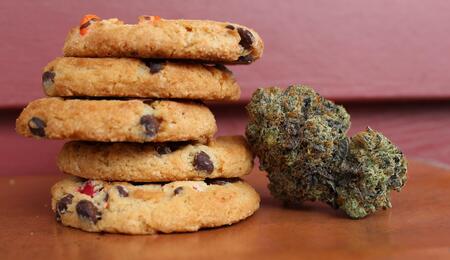Eating Weed? Both as Edible and Raw... Why Not!

Marijuana has been used as an inhalant but also as a beverage and food across many ancient cultures.
You might wonder whether we are stoned writing this, right? Stoned or not, this is a legit question. Smoke, vape and cooked are the common ways of consuming cannabis, but eating raw? You bet!
A fresh weed salad? It sounds nutritious, but does it have the same effect as consuming readily made marijuana-infused products such as drinks, spreads, sublingual drops, snacks, pills, mouth sprays, and whatnot. There is nothing strange about trying out "non-traditional" ways to use cannabis, and eating weed in its raw form is not an exception.
It's Actually an Ancient Tradition
Our distant ancestors are very likely to have tried raw weed, and if it was good for them, it should be good for us too. Obviously, they didn't consume edible weed in the form of smoothies, cookies and juices as we have it today, but marijuana-infused foods and drinks have been consumed throughout history, going back several millennia.
For instance, the Hindus were known to enjoy a drink named Bhang since at least 1000 B.C. It's a concoction that contains leaves and flowers of marijuana plants and has been traditionally consumed during religious festivities, such as Holi, a celebration of love and color. While the drink not exactly gets you high, it does induce euphoria.
A famous medicine in ancient China and India, weed became a thing in the Western world much later, somewhere in the early 19th-century. In the form of tinctures, the substance was prescribed to people with chronic pains and some digestive disorders. Over a century ago, marijuana had a status similar to that of alcohol. It was something to relieve stress and spice things up. Its use was apparently more widely accepted than alcohol in the U.S. at the end of the 19th and the beginning of the 20th century. The temperance movement even at one point advised alcohol consumers to opt for marijuana instead of booze as it didn't make people violent.
The 1960s were like the golden age of smoking weed, although, by this time, authorities everywhere reduced the legality of the naturally growing plant. While today you can legally buy weed in dispensaries in states where there is a law regulating adult use, the black market is still holding momentum. We are still due to see a fully comprehensive cannabis reform that will reignite the status of cannabis in society as it was in the past.
Think Twice Before Going Raw
If you really want to experiment and be eco-friendly, you can try eating raw weed. But truth to be told, it won’t have the same effect as consuming marijuana-based products or inhaling it or vaping it. So you just might be spending your weed unnecessarily.
On the sciency side, scientists have isolated more than 100 cannabinoids, and of all those, only a few—such as THC, CBD, and CBG (the so-called mother of all cannabinoids) is what give us the magical therapeutic effect. The issue with these cannabinoids is that they aren't necessarily potent unless being exposed to a higher temperature.
Raw weed contains cannabinoids in the form of carboxylic acids. So, delta-9-tetrahydrocannabinolic acid (THCA) is what would give THC once exposed to heat. Same for cannabidiolic acid (CBDA) that gives CBD, and cannabigerolic acid (CBGA) from where CBG comes from. Once they are exposed to light or heat from smoking or baking, the carboxylic acid group detaches, and then if there is THCA in the particular strain you're using, it is what will cause the sought-after high cerebral sensation.
Eating raw weed means that the acids are unlikely to convert in their more potent chemical form. With that, automatically less pleasure from eating weed. So, what's the catch then?
Well, It Just Might Be the Food Your Brain Needs
If you have already lost interest after reading that raw weed can’t make you that much high, you might reconsider and tap into more science insights and what research have to say on the topic. Weed, in its raw organic form, can act as a protector of brain cells.
According to one study published in the British Journal of Pharmacology, THCA might have a protective effect on brain cells. It might potentially help in the treatment of neuroinflammatory diseases and neurodegenerative conditions such as Huntington’s disease, the research implies. Another group of scientists came with a study in the journal International Immunopharmacology, also experimenting with raw weed and the effects of unheated cannabis extract.
As the abstract of the study reads, unheated cannabis extract and THCA are able to interact with proteins such as tumor necrosis factor alpha (TNF-alpha), a byproduct of acute inflammation processes in the body, which has a role in resistance to infection and cancers. The interaction is dose-dependent, and potentially it can support the immune system.
The most convenient way to use cannabis flower is to smoke it, however, you can always experiment with other ways of consumption.
Last but not least, a third study attests to the possible anti-nausea effects of THCA. Also published in the British Journal of Pharmacology, researchers explored the anti-nausea effects of THCA in mice within this effort. They found vomiting and nausea in rats were reduced, and THCA was the chemical to be blamed. More studies are however needed to confirm that the precursor of THC has the same effect on humans.
In a nutshell, judging from this research, the worst thing that can happen from eating raw food is freshening up your brain and potentially give it a boost to your immune system.
Research Difficulties
One of the biggest challenges for researchers studying the effects of acids like THCA is their instability in nature. It doesn't take much for the carboxylic acid groups to begin converting, and that's what's problematic about THCA in terms of research. Experimenting with ethanol, researchers have demonstrated that, after 10 days at 77ºF (25ºC), only 33% of the THCA remained in ethanol, and it was also revealed that losses of THCA can also occur while freezing. Scientists have to look for ways to ensure the stability of THCA from transforming promptly to THC. At least for the sake of science.
What’s on the Menu?
Raw weed might not be so tasty after all. Fortunately, there are various edible marijuana products on offer. From readily available gummies, cakes, pizza, ice cream, or other snacks to oils and tinctures with which you can enrich any meal you can think of—this way, weed will go smoother on the stomach. It works well both if you are doing it just for fun or for treating a condition that can range from mild to complex, including cancer.
Cannabis is unique thanks to its combination of therapeutic chemicals that are highly effective in soothing the pain related to various conditions. An increasing number of people reach for edible cannabis to treat muscle spasms, relieve nausea and vomiting, improve sleep or cope with depression and anxiety. Pharmaceutical companies are prominent players in this business, and they benefit a lot from edible products. Nevertheless, a number of edible products can be easily prepared on your own, given that you have sufficient (and the right) cannabis flower.
What Can Go Wrong with Eating Weed? The dosage.
An appropriate amount is crucial. Consumers have to synchronize their habits with the needs of their body. Increase the dosages only if necessary. Any increase should take place gradually. Bear in mind that edibles don't hit instantly, such as when inhaling weed. When marijuana is smoked, THC reaches the brain almost immediately, entering the blood system through the respiratory system. The show usually begins in less than 20-30 minutes, and it takes about 2-3 hours before the high is gone (given that you smoke THC strains).
On the other hand, the psychoactive effects of edibles can take anywhere between 30-90 minutes as the weed passes through the digestive tract where it's processed. Weed ingested as food may cause extended hours of high. You could get well stoned for good 4 hours. A lot of people have experienced even longer hours of pleasant dizziness and looseness. This is related to body weight, metabolism, gender, and other factors.
Cannabis edibles has grown into a huge industry over the last couple of years. But if you find the products on the pricey side, you can always try and make your own 'high' goodies.
Side effects may include slight paranoia in some users and impaired motor abilities, but only if you had a bit too much. It often happens at the beginning of consuming edible marijuana products, and it's the combination of the highly variable THC concentration and the long latency period that gives the sensations. It's under extremely rare circumstances that ingestion will lead to more serious side effects such as paranoid delusions, extreme sedation, hallucinations, or confusion.
Typically, eating edibles will result in dry mouth, sleepiness, or changes in visual perception. For these reasons, it is not recommended to mix the edibles with alcohol and certain medications, including blood thinners and antidepressants. One word of caution: pay extra attention to keep edibles out of children or animal reach, more so than a stash with grounded flower. Like other sweets, treats like weed cookies and gummies look more or less innocent, and it's best not to end up in the wrong hands.
Between 2005 and 2011, marijuana-related calls to U.S. poison control centers increased by 30% per year in states that regulate marijuana. Lots of these calls were connected with an unintentional ingestion of edible marijuana products like gummies, candies, cookies, and other baked goods.
Extra Tip: Try Juicing!
Whether you are still not over with the idea of ingesting some "fresh" weed, then what's better than a refreshing raw cannabis drink? A juice preserves all the cannabinoids and other vitamins and minerals contained in the plant without having to process the fibrous plant matter, which can sometimes be hard to digest.
If you don't like the taste of fresh juice from the cannabis plant, you can always enrich it with flavor by blending in other ingredients. All you need is a quality juicer and un-decarboxylated weed. You can use both buds and leaves, or if you are a grower with stalks of male cannabis in the garden, you can process almost the entire male plant into a drink.
So just chop the plant, add your favorite fruit or veggie and decorate your glass with an umbrella and you're ready to start the weekend a little bit earlier with a delicious cannabis cocktail. Cheers!



